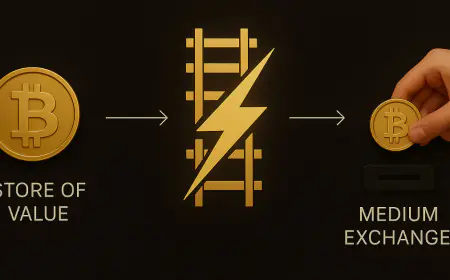How the Crypto Industry in Denmark Charts A Middle Path Between Potential and Risks
Denmark has positioned itself as a significant player in the digital finance sector, embracing cryptocurrencies with a unique blend of innovation and regulatory prudence. Since the global emergence of digital currencies, starting with Bitcoin in 2009, Denmark has seen a rising adoption of cryptocurrencies for investment and transactions, driven by its high internet penetration rate […]

Denmark has positioned itself as a significant player in the digital finance sector, embracing cryptocurrencies with a unique blend of innovation and regulatory prudence. Since the global emergence of digital currencies, starting with Bitcoin in 2009, Denmark has seen a rising adoption of cryptocurrencies for investment and transactions, driven by its high internet penetration rate and tech-savvy population.
Notably, Denmark’s approach to digital currencies is marked by strategic regulatory responses, fostering a balanced environment that encourages industry growth while safeguarding consumer interests, ensuring both innovation and protection within its structured framework.
Regulatory Landscape
Denmark’s regulatory framework for cryptocurrencies is an exemplar of meticulous governance and forward-thinking policy-making. The Danish authorities have developed a legal framework that strives to balance the need for innovation with the necessity of protecting consumers and maintaining financial stability. Unlike some jurisdictions that have taken a more hands-off approach or those that have imposed stringent regulations, Denmark has charted a middle path, recognizing the potential of digital currencies while being acutely aware of their risks.
The cornerstone of Danish cryptocurrency regulation is its emphasis on clarity and compliance. The Danish Financial Supervisory Authority (Finanstilsynet) plays a pivotal role in this ecosystem, overseeing the operations of crypto-related businesses and ensuring adherence to financial regulations. This includes monitoring anti-money laundering (AML) efforts and combating the financing of terrorism (CFT) through digital assets.
Comparatively, Denmark’s stance on cryptocurrency regulation is in sync with broader European Union trends, albeit with certain national specificities. The country has been proactive in implementing EU directives related to digital assets, particularly those concerning AML and consumer protection. However, Denmark also demonstrates a degree of flexibility, allowing for a more tailored application of these directives to suit its domestic market conditions.
Taxation Policies for Cryptocurrencies
The taxation of cryptocurrencies in Denmark is primarily governed by guidelines that categorize profits from crypto transactions as taxable income. This classification means that any gains derived from the buying and selling of digital currencies are subject to taxation under the personal income tax regime. The tax rate varies depending on the total income of the individual, including gains from cryptocurrencies. However, it is crucial to note that losses in crypto trading can also be considered for tax deduction purposes, offering a semblance of balance in the fiscal treatment of these digital assets.
Business entities dealing in cryptocurrencies face a different set of tax implications. Companies engaged in crypto trading are taxed on their profits as part of their business income. This includes not only direct trading activities but also indirect crypto-related operations such as mining or providing cryptocurrency payment services. The tax authorities require detailed documentation of all transactions to ensure accurate tax reporting and compliance.
Moreover, the Danish tax system also contemplates the VAT (Value Added Tax) implications for transactions involving cryptocurrencies. While the buying and selling of cryptocurrencies themselves are exempt from VAT, goods and services purchased using digital currencies are subject to VAT, similar to transactions conducted with traditional currencies.
Crypto-assets: Risks and Challenges
One of the primary risks associated with crypto-assets is their inherent volatility. The prices of cryptocurrencies can fluctuate wildly, driven by factors ranging from global economic trends to speculative trading. This volatility poses a considerable risk for investors, especially those who are not well-versed in the market dynamics of cryptocurrencies.
Another critical challenge is the issue of security. Cybersecurity threats such as hacking and phishing attacks pose significant risks to both individual cryptocurrency holders and exchanges. The decentralized and digital nature of these assets makes them a target for cybercriminals, necessitating robust security measures to safeguard investments.
Regulatory risks also play a pivotal role in the crypto-assets landscape. The evolving nature of regulations surrounding cryptocurrencies can lead to uncertainties and abrupt changes in the market. For instance, new compliance requirements or changes in tax laws can significantly impact the profitability and operations of crypto-related businesses.
To mitigate these risks, a multi-faceted approach is required. Investors need to exercise due diligence, educating themselves about the market trends and the security aspects of handling cryptocurrencies. On the regulatory front, authorities must strive to create a balanced regulatory environment that protects investors and the integrity of the financial system, while also fostering innovation and growth in the crypto industry. This involves continuous monitoring of market developments, dialogues with industry experts, and adapting regulations in response to emerging challenges and technological advancements.
Cryptocurrency Usage Trends in Denmark
The utilization of cryptocurrencies in Denmark reflects a sophisticated integration of digital assets into both the consumer and business spheres. This trend underscores a burgeoning inclination towards embracing digital currencies for diverse purposes, spanning from investment opportunities to their application in everyday transactions. The Danish market, characterized by a high degree of technological literacy and an openness to innovation, has witnessed a significant uptick in cryptocurrency usage.
In the investment domain, cryptocurrencies have garnered considerable attention from individual investors and institutional entities alike. The allure of high returns, despite the accompanying risks, has propelled cryptocurrencies to become a notable component of investment portfolios. Notably, the Danish investor demographic is marked by a penchant for diversification, and cryptocurrencies offer a novel avenue for asset allocation.
On the commercial front, an increasing number of businesses in Denmark are integrating cryptocurrencies into their transactional frameworks. This integration is not limited to tech-savvy startups; established enterprises are also exploring cryptocurrencies as a means to enhance their payment methodologies. Cryptocurrencies are being employed not only as a medium of exchange for goods and services but also as a mechanism for international trade, capitalizing on their ability to facilitate cross-border transactions with relative ease and lower transaction costs.
The proliferation of cryptocurrency usage in Denmark is also facilitated by the supportive infrastructure, including a network of crypto ATMs and a growing number of businesses accepting digital currencies. This infrastructure, coupled with a regulatory environment that fosters innovation while ensuring consumer protection, has been instrumental in cultivating a conducive ecosystem for the growth of cryptocurrency usage in the country.
Blockchain Technology in Denmark
The application of blockchain in Denmark spans a wide array of industries, from healthcare to supply chain management and beyond. In the realm of public services, blockchain initiatives are being explored to enhance transparency, efficiency, and security. For example, blockchain’s immutable ledger capabilities are being utilized to improve record-keeping processes in government departments, thereby enhancing the integrity of data and reducing the potential for fraud.
In the private sector, Danish companies are harnessing the power of blockchain to revolutionize supply chain management. By utilizing blockchain’s ability to provide a transparent and unalterable record of transactions, businesses are able to track the movement of goods with unprecedented accuracy. This capability is particularly valuable in industries where authenticity and provenance are of paramount importance, such as in the pharmaceutical and luxury goods sectors.
The Danish educational and research institutions are also at the forefront of exploring blockchain’s potential. These institutions are not only educating the next generation of blockchain professionals but are also engaged in cutting-edge research to push the boundaries of what blockchain technology can achieve. This academic engagement is crucial for fostering an environment of innovation, where new uses of blockchain technology can be explored and developed.
Initial Coin Offerings (ICOs) and Securities Laws
The Danish Financial Supervisory Authority (FSA) has taken a nuanced stance towards ICOs, recognizing them as a significant component of the digital economy. However, this recognition comes with a caveat – a stringent emphasis on compliance with securities laws. In Denmark, ICOs are scrutinized to determine whether the tokens offered can be classified as securities. This classification hinges on several factors, including the rights attached to the tokens and the expectations of the investors.
If an ICO is deemed to fall under the purview of securities laws, it is subject to a range of regulatory requirements, including registration, disclosure, and reporting obligations. These requirements are instrumental in safeguarding investors from fraudulent or speculative ventures, ensuring that only credible and transparent ICOs operate in the Danish market.
Cryptocurrency Exchanges and Trading Platforms
Danish cryptocurrency exchanges operate under a regulatory regime that prioritizes the security of transactions and the protection of users’ assets. In adherence to stringent regulatory standards, these platforms implement advanced security measures, including robust encryption protocols, two-factor authentication, and cold storage of digital assets. These measures are critical in mitigating the risks associated with digital currency transactions, such as hacking and fraud.
Compliance with regulatory norms is another cornerstone of cryptocurrency exchanges in Denmark. These platforms are required to adhere to AML and KYC regulations. This compliance ensures that the exchanges operate with transparency and integrity, fostering trust among users and regulators alike.
The user experience on Danish cryptocurrency exchanges is enhanced by a focus on user interface design and customer support. These platforms strive to demystify the process of trading cryptocurrencies, making it accessible to a broader audience. Features such as real-time market data, user-friendly dashboards, and responsive customer service are integral to this endeavor, ensuring that users can navigate the complexities of the crypto market with ease.
Moreover, the dynamics of cryptocurrency trading in Denmark are shaped by a confluence of global and local factors. Market trends, regulatory developments, and technological innovations continually influence the trading environment. Danish exchanges, therefore, are not static entities; they are evolving platforms that reflect and adapt to the changing contours of the global crypto landscape.
Impact of EU Regulations on Danish Crypto Industry
One of the primary EU directives impacting the Danish crypto industry is the AML framework. The implementation of AML directives in Denmark underscores a commitment to preventing the misuse of cryptocurrencies for illicit activities. These regulations necessitate stringent compliance measures from crypto-related businesses, including thorough customer due diligence and transaction monitoring. The Danish implementation of AML directives reflects a balanced approach, aiming to curb illegal activities without stifling innovation and growth in the crypto sector.
Furthermore, the General Data Protection Regulation (GDPR) is another critical EU regulation influencing the Danish crypto sphere. GDPR’s emphasis on data privacy and protection has implications for how crypto businesses handle user data, ensuring enhanced security and confidentiality. This regulation mandates strict protocols for data processing and storage, providing a safeguard for personal information in the digital currency domain.
Conclusion
The state of the crypto industry in Denmark presents a dynamic and evolving landscape, characterized by a blend of innovation, regulatory foresight, and strategic adaptation. The Danish approach to cryptocurrencies and blockchain technology showcases a nuanced understanding of these digital phenomena, balancing the potential for economic advancement with the imperative of maintaining financial stability and consumer protection. Looking ahead, the future of the crypto industry in Denmark appears promising, with potential for further growth and diversification. The continuous evolution of technology, coupled with an adaptive regulatory framework, positions Denmark as a conducive environment for crypto-related innovations. However, the industry also faces challenges, primarily in navigating the complexities of global economic trends and evolving regulatory landscapes.
What's Your Reaction?





































































































